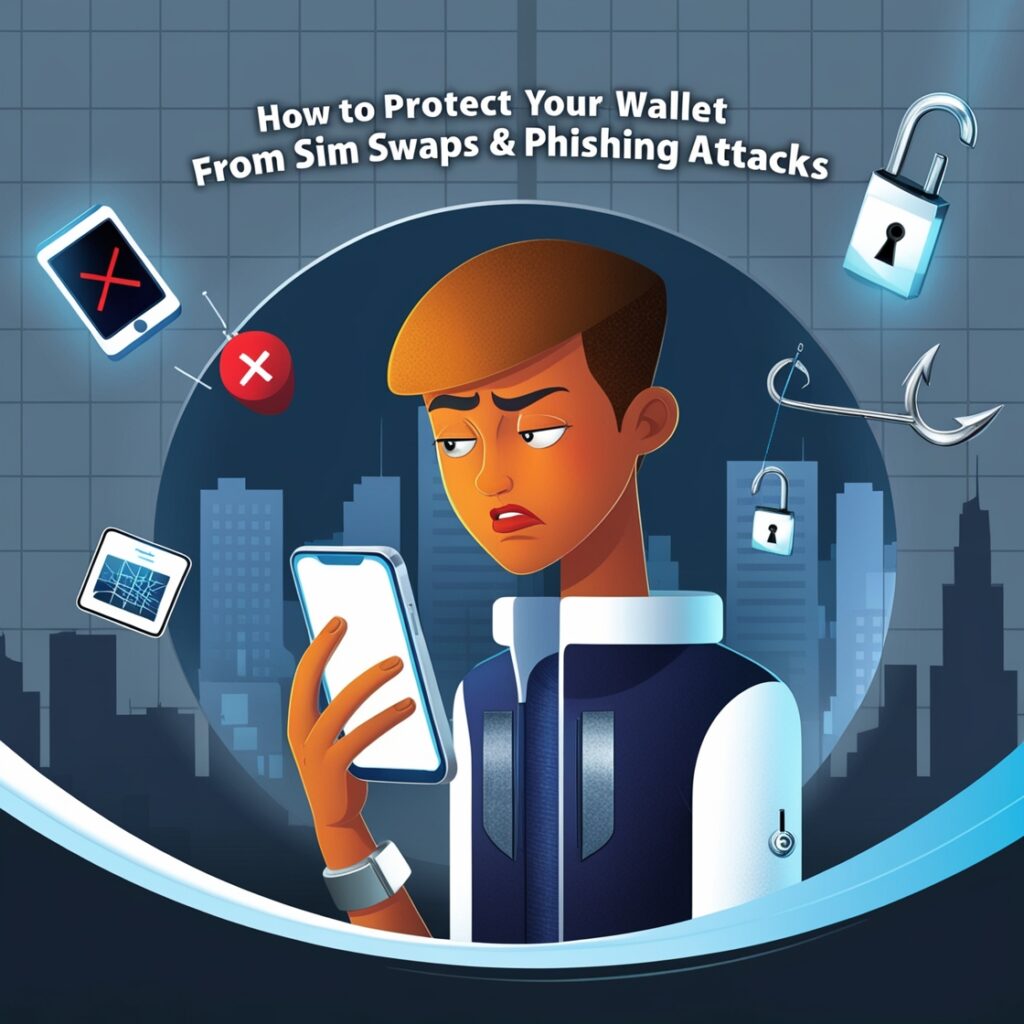Introduction
Cybercriminals are always finding new ways to steal crypto, and two of the biggest threats today are SIM swap attacks and phishing scams. If you don’t protect your crypto wallet properly, you could lose everything in seconds. But don’t worry! This guide will teach you exactly how to safeguard your assets with simple, practical steps.
Understanding SIM Swap & Phishing Attacks

What is a SIM Swap Attack?
A SIM swap attack is when hackers take control of your phone number by transferring it to a new SIM card. Once they do this, they can access your SMS-based two-factor authentication (2FA), allowing them to break into your crypto wallet and steal funds.
Example: Imagine you have a toy that requires a special key to open. Now, what if someone tricks the store into giving them a copy of your key? They can now open your toy and take whatever is inside. That’s exactly what hackers do with your phone number in a SIM swap attack!
What is a Phishing Attack?
Phishing is when hackers trick you into giving them your wallet credentials, private keys, or personal information by pretending to be a legitimate company or website. These scams usually come through emails, messages, or fake websites.
Example: Imagine a stranger knocks on your door and says, “I’m your school principal! Give me your lunchbox password, and I’ll keep your food safe.” If you trust them and share your password, they’ll take your lunch. Hackers do the same by pretending to be trusted websites or companies.
How SIM Swap Attacks Work
Real-Life Example
In 2020, a hacker stole $45 million in Bitcoin from a high-net-worth investor through a SIM swap attack. The hacker convinced the victim’s mobile provider to transfer their phone number to a new SIM, intercepted the 2FA codes, and drained their wallet.
Steps Hackers Take:
- Gather personal data through social media, data leaks, or phishing.
- Contact your mobile provider, pretending to be you.
- Convince or bribe the provider’s employee to swap your number.
- Receive your SMS codes and break into your accounts.
- Transfer crypto funds before you realize what’s happening.
Example: Imagine a thief calls your school and pretends to be your parent. They convince the school to let them pick you up. Once you’re in their car, they take you where they want. That’s how hackers steal your phone number and access your wallet.
How Phishing Attacks Work
Common Phishing Techniques
- Fake emails from crypto exchanges asking you to “verify” your wallet.
- Malicious links that redirect you to a fake wallet login page.
- Fake airdrop scams offering free tokens if you enter your private key.
- Social media impersonation, where scammers pretend to be support teams.
Real-Life Example
A hacker created a fake website that looked exactly like MetaMask and sent out emails urging users to log in. Thousands of users unknowingly entered their seed phrases, losing their entire holdings.
Example: Imagine getting a letter that looks like it’s from your school, telling you to pick up a free toy from a new shop. But when you go there, it’s actually a trap, and they take your lunch instead. Phishing scams work the same way!
Signs That You Might Be a Target
Unusual Account Activity
- Unexpected login attempts
- Password reset emails you didn’t request
- Transactions you don’t recognize
Example: You come home and find your toy chest open with some toys missing, even though you didn’t touch it. That’s what happens when hackers try to access your wallet without your permission.
Loss of Mobile Signal
- Suddenly unable to make calls or send texts
- Receiving messages about a SIM card change
Example: Imagine you’re using your walkie-talkie to talk to a friend, but suddenly, your voice stops working, and someone else is talking instead. That’s what happens when someone hijacks your phone number!
Suspicious Emails & Messages
- Emails asking you to log into your wallet
- Requests for personal details or private keys
- Messages with urgent “security warnings”
Example: Imagine a stranger gives you a letter saying, “Your principal needs your notebook password urgently!” You’d be suspicious, right? Hackers do the same thing with emails to steal your crypto wallet info.
Best Practices to Protect Your Crypto Wallet

1. Secure Your SIM Card
- Use a PIN lock on your SIM.
- Call your mobile provider and enable SIM lock protection.
- Never share your phone number on social media.
Example: Imagine putting a strong lock on your toy box so no one else can open it. That’s what a SIM PIN does to protect your phone number.
2. Enable Two-Factor Authentication (2FA)
- Use Authenticator apps (Google Authenticator, Authy) instead of SMS 2FA.
- Never store 2FA backup codes on cloud storage.
Example: Imagine needing both a key and a secret code to open your treasure chest. Even if someone steals your key, they still can’t open it without the code. That’s what 2FA does for your accounts.
3. Use a Hardware Wallet
- Store your crypto in a cold wallet like Ledger or Trezor.
- Keep your seed phrase offline and never share it.
Example: Imagine storing your favorite toy in a super-strong safe instead of leaving it outside. A hardware wallet is like that safe for your crypto.
4. Be Cautious with Links & Emails
- Always check the URL before logging into any crypto site.
- Never click on links from unknown senders.
- If in doubt, go to the website directly instead of using email links.
Example: If a stranger gives you a map saying there’s free candy at a new store, would you follow it? No! You’d check with a trusted adult first. Always verify links before clicking.
5. Regularly Monitor Your Accounts
- Check wallet activity logs frequently.
- Set up alerts for suspicious login attempts.
- Use security monitoring tools to track your crypto wallet.
Example: Imagine checking your piggy bank every day to make sure no coins are missing. That’s what monitoring your crypto wallet does!
What to Do If You’re a Victim of SIM Swap or Phishing
Immediate Steps to Take
- Contact your mobile provider and regain control of your number.
- Change all passwords and enable stronger security settings.
- Transfer your crypto to a safe wallet ASAP.
Reporting the Attack
- Report the fraud to your crypto exchange immediately.
- File a complaint with your local cybercrime division.
- Inform your mobile provider to prevent future attacks.
Recovering Your Assets
- If funds were stolen from an exchange, ask if they can reverse the transaction.
- Use blockchain explorers to track the stolen funds.
- Consider working with crypto recovery experts if a large sum was lost.
Final Thoughts & Call to Action
Protecting your crypto wallet from SIM swap and phishing attacks is critical in today’s digital world. By following the steps in this guide, you can reduce the risk of falling victim to hackers.



